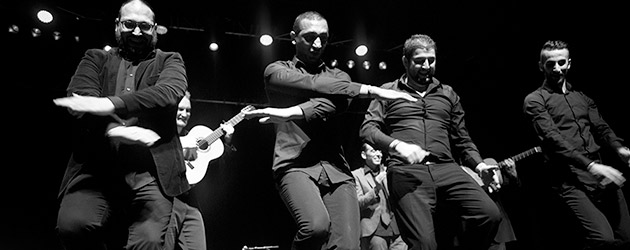Text : Estela Zatania
Photos: Jean Louis Duzert
Friday, January 24th, 2015. Nimes (France)
FRENCH FLAMENCO COMES OF AGE
1st Part: Cante-Cristo Cortés, Juan Cortés, Emilio Cortés Jesús de la Manuela. Guitar-Antón Fernández, Antonio Cortés. 2nd Part: Cante-Tony Fernández, Juan Gómez (el de Alpujarra). Guitar-Pepe Fernández, Manuel Gómez. Rhythm-Juan Luis Fernández. 2nd Part: Cante-Paco Santiago, Juanito Santiago, José Santiago «de la Negreta», Bastián Santiago. Guitar-José Boleco, Luis Gómez. Cante and cajón-Pedro el Misto. Artistic collaboration-Pepe Linares.
Enough rhythm to stop a freight train
There was a double program Friday at the Festival de Flamenco de Nimes. At six P.M., at the Institut Emmanuel d'Alzón, Miguel Ortega of Los Palacios (Sevilla), gave an acoustic cante recital with the guitar accompaniment of Salvador Gutiérrez. This singer, holder of the coveted Lámpara Minera (2010), in addition to other important prizes, is one of the most knowledgeable and experienced of his under-forty generation. True to the most classic flamenco singing, he nevertheless has his own personality. Alegrías, malagueñas de la Trini and of Mellizo, a varied assortment of soleá, siguiriyas, tientos tangos, bulerías and his famous interpretation of the fandangos of Paco Toronjo, earned the singer prolonged heartfelt applause that was more than warranted.
Several kilometers outside Nimes, at the Paloma, a large venue devoted to contemporary or experimental music, at eight P.M., we attended a flamenco happening of major proportions. Some twenty French artists, with a tangle of roots, second and third generation immigrants with ties to Algeria, and in some cases passing through Almería, people who completely identify with flamenco as a form of life, who don't dream, as other non-Spaniards do, of taking courses in Spain, because they have their own flamenco ecosystem, with no complexes of any kind.
The concept most of us have, or had of French flamenco, is reduced to memories of the nineteen-sixties, and guitarist Manitas de Plata (Ricardo Baliardo, 1921-2014), from the south of France like the artists we saw last night, a cult figure who was endorsed in his day by Pablo Picasso and Brigitte Bardot, but who suffered the ostracism of the flamenco community because of his defective rhythm. I don't know if there are any family ties between Manitas and last night's performers, but I can vouch for the fact that these French flamencos have no rhythmic shortcomings, and they breathe compás just as in Seville, Jerez, Granada and Cádiz.
Divided in three groups of interpreters with shared family ties, and informally headed by Cristo Cortés, Tony Fernández and Paco Santiago, these men, young and old, (no women), do not dream of recording with a multinational record company, nor do they draw up proposals for elaborate works, nor do they even participate in major festivals in Spain. They are self-sufficient, and this gives them the freedom to interpret flamenco in their own way. A way which is perhaps a bit retro, but in the most positive sense. The voices are in the line of Camarón to a greater or lesser extent, and the guitar-playing is influenced by Paco, as is to be expected in the year 2015, but it is also reminiscent of the Granada sound of Habichuela and Marone, particularly when they play in E position.
We enjoyed their fandangos personales, siguiriyas, tientos, cante minero, fandango de Huelva y soleá done with exquisite taste, but most of all, the bulerías. Bulerías full of substance, gushing forth with life and intensity, with enough rhythm to stop a freight train. I remember with certain nostalgia when bulerías used to sound like that in Spain. The new generation of guitarists in Spain has gone for a more laidback contemporary sound, the music has been domesticated and tamed. These French have no interest in reinventing flamenco, or «evolving» it…they're too busy living it as a means of expression.
A long series of bulerías dance bits, and one wise-guy song, «Somos Gitanos Americanos» ('we're American gypsies'), in the irreverent line of Diego Carrasco, turns us all into believers on the spot.
